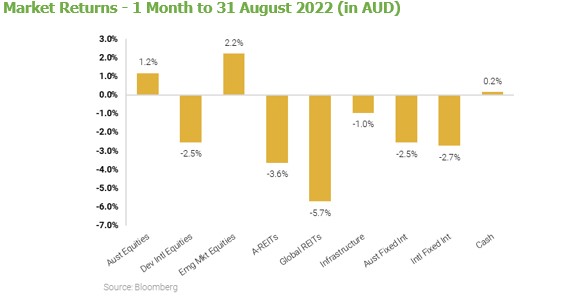Sovereign Wealth Partners and InvestSense Pty Ltd
Market Commentary
August was a weak month for markets, which started well but ended with US and European markets down around 5%, and the UK and Australia down by 2%. Japan was the best performer, down by just 1%.
Around the middle of the month, the strength of the US economy (and the interest rate levels that this implied) had already weighed on markets, but later in the month it was Jerome Powell’s Jackson Hole speech that confirmed the down trend in markets. The Federal Reserve has now made it very clear that a rate induced recession that ‘the US has to have’ is now very likely, unless there is a dramatic fall in inflation.
Given the strength of the US Dollar (typically a harbinger of doom for less developed markets) emerging markets have been remarkably resilient in recent months. Even the embattled Chinese market ended the month in positive territory, while many Latin American markets posted returns in the mid-single digits (Brazil) or double digits (Argentina).
This capped another bad month for bonds, most of which lost more than normally riskier equities in August. High yield bonds and government bonds both fell by similar amounts (4-5%) because many high yield bonds that carry more credit risk tend to pay floating rate coupons, while most government bonds have fixed coupons and are more sensitive to interest rate changes. This is also why investment veterans of the Seventies say that there is nowhere to hide in a stagflationary economy.
On a slightly brighter note, most of the diversified bond funds that have become popular in Australia – which tend to be biased to very high quality local floating rate bonds – performed well in August, and many were actually in positive territory.

Looking Forward
You would think that the bond market signalling the dramatic fall in inflation the world craves would be a good thing, right? 1 year expected inflation (implied by the difference between fixed and inflation adjusted US Government Bonds) has plummeted in recent months. However, there are 2 significant notes of caution. Firstly, the inflation linked bond market is notoriously illiquid and can be affected by ‘technical’ factors (usually lack of availability/liquidity, even in the US). Perhaps more ominously, such falls in so-called break-even rates are associated with a rising short-term real cost of capital, or real rates.
While it is arguable that this equates to the actual cost of capital in the shorter maturities, due to those ‘technical’ factors it is undeniable that the we are coming from a period where the cost of capital was very low while companies have been able to grow earnings strongly in a very inflationary environment.
The other ominous sign is that periods when real short-term rates have risen dramatically in a very short period of time (late 2018 and early 2020,) have also been periods off extreme market stress and low liquidity. There are layers of causality and correlation in all of this, something we will be unpicking with various economists and fund managers, but we suspect that this is a manifestation of the tightening of financial conditions that everyone has been waiting for.
Otherwise, we continue to focus on all things inflation and interest rates, and last week’s US CPI print provided some more data points (and, long-term, it will probably matter more for Australian savers and mortgage holders than last week’s RBA rate decision).





